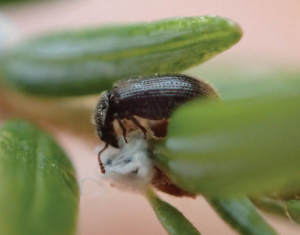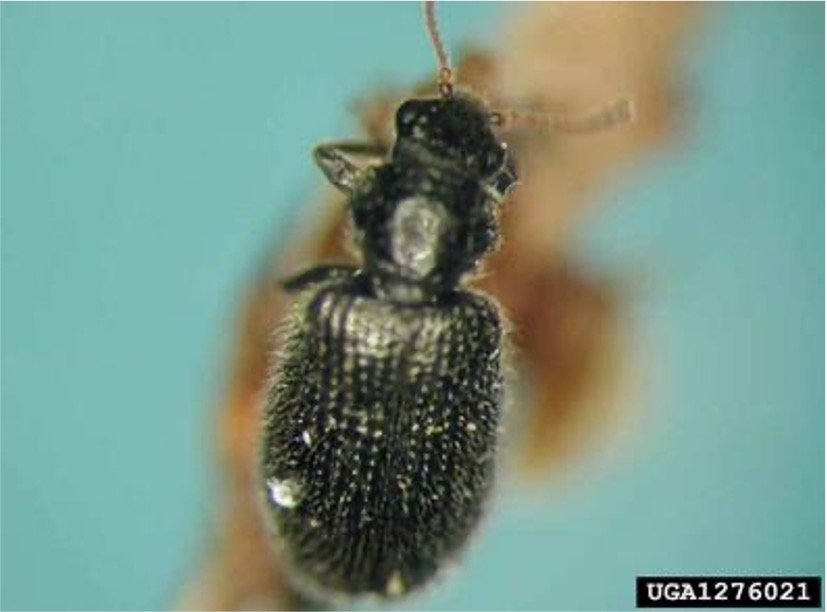Jeremiah Foley: Beetles against bugs in the fight to save hemlocks

The following story was written in December 2021 by Nik Buckwalter in ENGL 4824: Science Writing as part of a collaboration between the English department and the Center for Communicating Science.

Have you ever noticed white, almost fungi-like patches growing all over the hemlock trees around town or in the forest? These white fluffs are insects—true bugs—called the Hemlock Woolly Adelgid. Since the mid-1950s, the Hemlock Woolly Adelgid has been one of the biggest ecological threats to eastern North American hemlock species. Dr. Jeremiah Foley wants to do something about that.
In eastern North America, eastern hemlock stretches from Nova Scotia, Canada, to northern Alabama and is home to many rare species of birds and plants. Hemlock Woolly Adelgid is a tiny, invasive insect native to Japan, identified by the white woolly masses that form on the underside of branches during the cooler months of October to late March. Using its straw-like mouth, this bug drinks stored plant nutrients from hemlocks and cuts off nutrients flowing throughout the tree. Although it is tiny, an uncontrolled infestation can kill a tree. Since the original invasion of the Hemlock Woolly Adelgid, we have lost many hemlock giants that were originally part of eastern North America’s forest landscape over 300 years ago.
Fortunately, Foley is prepared to fight fire with fire.

A 2021 Ph.D. graduate from the Department of Entomology at Virginia Tech, Foley is currently a post-doctoral research ecologist for the U.S. Department of Agriculture-Agricultural Research Service-Invasive Plant Research lab in Florida. While at Virginia Tech, he studied the mass production and urban establishment of a beneficial predator, the Laricobius beetle, as part of his Ph.D. research. Laricobius feeds on adelgids.
Foley was originally interested in plants and their evolutionary relationship with insects. He was introduced to the science of biological control as an intern with the U.S. Department of Agriculture. There, he learned how pivotal insects are in controlling invasive pest populations.
Rather than relying on the use of pesticides as the sole means of combating non-native invasive pests, Foley and the forest entomology lab at Virginia Tech introduced Laricobius beetles into forests with the goal of restoring the natural balance of this system, preventing the further loss of our hemlocks, and ultimately restoring the ecology of the system to pre-adelgid days.

The Laricobius beetle, specifically Laricobius nigrinus, has many biological attributes that make it an ideal natural enemy for the Hemlock Woolly Adelgid. The hemlock tree remains physiologically active during the winter season, and during this time, the Hemlock Woolly Adelgid takes control of the tree’s nutrient production. Similarly, Laricobius emerges from its summer dormancy and starts feeding on Hemlock Woolly Adelgid in the cooler months of the year. When the Laricobius beetle is introduced into the ecosystem, both the adult beetles and their larvae can consume most of the growing Hemlock Woolly Adelgid.
Over the past twenty years, the Virginia Tech forest entomology lab has been mass producing and releasing beetles to land managers across multiple states. Recently, as part of the ongoing research that determines the distribution of Laricobius since its initial release, Foley discovered that these beetles had spread from their original forested release locations to heavily urbanized locations, including Blacksburg.
“The establishment of Laricobius in Blacksburg and the surrounding urbanized environments is promising news for homeowners,” Foley says. “Laricobius is an added level of protection against the Hemlock Woolly Adelgid for homeowners who might or might not know if they have adelgid-infested hemlocks on their property.”
Foley set out to formally document these discoveries. By splitting Blacksburg into quarter-mile grids, he randomly surveyed each grid for the presence of hemlocks, hemlocks with Hemlock Woolly Adelgid, and hemlocks with both Hemlock Woolly Adelgid and Laricobius. To sample for the beetles, Foley and his team used a standardized sampling tool called a beat sheet. Beat sheeting is typically done by hitting a branch of an adelgid-infested hemlock and collecting the fallen beetles.

“Sampling for Laricobius has gotten the public excited about this research,” says Foley. “After seeing some strange guy hitting their tree with a stick, homeowners and passersby can’t help but ask what we are doing. We tell them that we are sampling for beneficial predators helping to protect their trees, which inevitably leads to the conversation about ongoing research at Virginia Tech that is directly benefiting Blacksburg residences.”
While finding Laricobius beetles in Blacksburg might have been easy, Foley’s migration from South Florida to Blacksburg for graduate school and back to Florida to work as a post-doctoral researcher proved more difficult.
“The primary hurdle for me now is that my bug wakes up for winter, and in South Florida, there is no winter,” says Foley. “The beetles are small, the pest is even smaller, so that’s been difficult, but every system has its challenges.”
Despite the hurdles that Foley encountered in his research, he and his team continued to mass produce and release beetles throughout eastern North America. Dormant beetles are kept in soil containers. They emerge once temperatures become cooler, in early autumn, and are then sent out for release to land managers dealing with heavy infestations of Hemlock Woolly Adelgid.
Although Foley moved on from Virginia Tech, research on the Laricobius beetle dormancy and mass-production processes has continued. Hopefully, soon, the North American hemlock ecosystem will thrive again.


